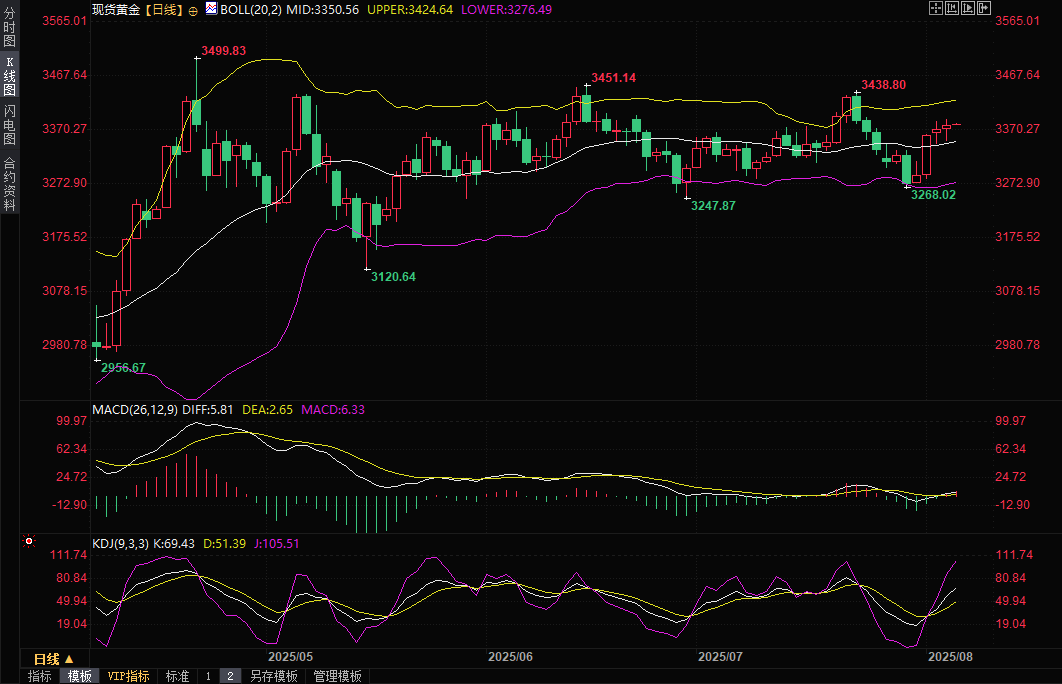Gold trading reminder: Is the Fed about to undergo a major "blood transfusion"? Triple positive factors provide support, and gold prices have risen for four consecutive days, approaching the 3400 mark.
2025-08-06 07:47:04

Expectations of interest rate cuts rise: Gold's safe-haven luster shines
Gold's strong performance is closely tied to market expectations of the Federal Reserve's monetary policy. Unexpectedly weak US employment data for June, showing lower-than-expected job growth and significant downward revisions to data for the previous two months, has fueled market concerns about an economic slowdown. According to the Chicago Mercantile Exchange's FedWatch tool, the probability of a September rate cut has soared to 91%, with the market anticipating a cumulative 130 basis points of cuts by October 2026. Goldman Sachs predicts that the Fed may cut interest rates three times starting in September, by 25 basis points each time, and could even cut by 50 basis points if employment data deteriorates further.
Although the US dollar index rebounded to 99.07 on Tuesday, it ultimately retreated to 98.76, indicating a weakening rebound. The dollar's weakness provided solid support for gold prices, attracting bargain-hunting and helping them resist any correction. Daniel Ghali, commodity strategist at TD Securities, said weak employment data and the Trump administration's decision to replace the director of the Bureau of Labor Statistics reinforced the market's view that the dollar's value as a store of value is weakening. This has reinforced gold's status as a traditional safe-haven asset, and investor demand continues to grow.
Tariff policy impact: a dual driver of the economy and gold prices
The Trump administration's tariff policies have had a profound impact on gold prices and the economy. The U.S. trade deficit narrowed by 16.0% in June to $60.2 billion, the lowest level in two years. The trade deficit with China plummeted to $9.5 billion, the smallest in 21 years. This was due to Trump's sweeping tariffs on imported goods, which led to a sharp decline in imports of consumer and industrial goods. Record-breaking capital goods exports supported a 3.0% increase in U.S. GDP in the second quarter, reversing a 0.5% contraction in the first quarter.
However, the side effects of tariffs are becoming apparent. The US Services PMI fell to 50.1 in July, below the market expectation of 51.5, indicating a near-stagnation in service sector activity. Businesses reported that high tariffs have pushed up input costs, with the ISM survey's Prices Paid index rising to 69.9, its highest level since October 2022. The employment index further declined to 46.4, highlighting weakening economic activity. Oren Klachkin, an economist at Nationwide Financial Markets, noted that the negative impact of high tariffs will outweigh any positive effects of reduced policy uncertainty.
For the gold market, inflationary pressures and economic uncertainty caused by tariffs have further enhanced its safe-haven appeal. Investors are concerned that high tariffs could push up prices and weaken economic growth, driving capital into the gold market. Intensified trade frictions between the Trump administration and countries like Canada and Germany, coupled with global economic uncertainty, have further boosted demand for gold.
Federal Reserve personnel changes: uncertainty in market trends
The Federal Reserve's personnel changes have added uncertainty to gold prices. Trump announced that he will soon announce an interim replacement for Fed Governor Kugler and is considering four candidates to succeed current Chairman Powell, ruling out Treasury Secretary Bensont. Market expectations are that the new governor and chair may favor a dovish monetary policy, which would depress the dollar and Treasury yields, providing upward momentum for gold prices.
Eugene Epstein, head of North American trading at Moneycorp, noted that Kugler's successor's dovish stance could lead to a weaker dollar, which would be a long-term positive for gold prices. Trump's dismissal of the head of the Bureau of Labor Statistics and his plan to announce his replacement soon signal his intention to manipulate economic data, increasing market volatility and prompting investors to seek the safety of gold. The market is also awaiting next week's release of the July core CPI data, which is expected to rise by 0.3% month-over-month and 3.0% year-over-year, respectively. If inflation exceeds expectations, it would further reinforce expectations of interest rate cuts and push up gold prices. However, if inflation moderates, it could put pressure on gold prices in the short term.
Future Trend Outlook: Opportunities and Risks of Gold Prices
The gold market's rally is driven by expectations of rate cuts, inflationary pressures triggered by tariffs, and Federal Reserve personnel changes. In the short term, gold prices are expected to remain strong, supported by safe-haven demand and expectations of rate cuts, potentially breaking through the recent high of $3,390/oz. However, if next week's US August inflation data falls short of expectations or if the Fed's personnel changes are unexpected, gold prices could face the risk of a correction. In the long term, global economic uncertainty and geopolitical risks will continue to support gold. Trump's trade policies and the direction of the Fed's monetary policy will be key variables. Investors should closely monitor expected changes in CPI data, the progress of trade negotiations, and Fed appointments, and monitor speeches by Fed officials to seize investment opportunities in the gold market.

(Spot gold daily chart, source: Yihuitong)
At 07:45 Beijing time, spot gold was trading at $3,382.47 per ounce.
- Risk Warning and Disclaimer
- The market involves risk, and trading may not be suitable for all investors. This article is for reference only and does not constitute personal investment advice, nor does it take into account certain users’ specific investment objectives, financial situation, or other needs. Any investment decisions made based on this information are at your own risk.





















